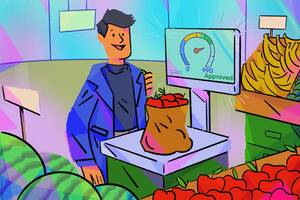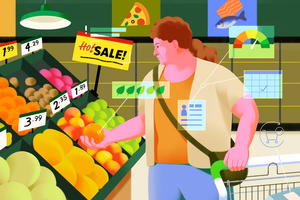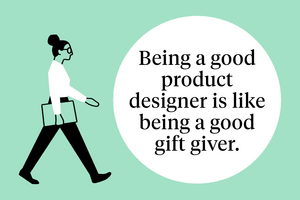In the effort to combat the burgeoning problem of obesity, authorities such as the United States Centers for Disease Control and Prevention and the World Health Organization promote the benefits of healthy eating plans that include plenty of fruits and vegetables. Individuals concerned with their weight often internalize that message. But they frequently do so in an irrational way. According to research by Alexander Chernev, an associate professor of marketing at the Kellogg School of Management, many think that adding a “healthy” option, such as a side dish of celery and carrots, to a high-calorie meal such as a cheesesteak somehow reduces the meal’s overall calorie content.
Chernev’s research also gives the tale an added twist: the more serious that individuals are about dieting, he finds, the more likely they are to fall for this “side salad illusion.” “People often behave in a way that is illogical and ultimately counterproductive to their goals,” Chernev says. “We’ve shown that people on a diet are more likely to underestimate the calorie count of combinations of healthy and unhealthy meals.”
The Dieter’s Paradox
Information about the “dieter’s paradox,” as Chernev calls it, emerged from a nationwide study in which more than 1,000 respondents were asked to estimate the calorie count of a variety of meals. About half the respondents saw a series of unhealthy meals: a hamburger, a bacon and cheese waffle sandwich, chili with beef, and a meatball pepperoni cheesesteak. The rest saw these same unhealthy meals accompanied by a healthy item—a few celery sticks, a small organic apple, a small salad without dressing, and a side dish of celery and carrots, respectively.
Respondents who saw only the unhealthy meals estimated that they contained 691 calories on average. But those who saw those same meals accompanied by the healthy items assessed the average calorie count at just 648. For example, participants shown a bowl of chili rated it as averaging 699 calories; however, participants who viewed the same bowl of chili combined with a green side salad rated it as having only 656 calories. In every case the addition of the healthy food item led to the erroneous perception that the number of calories had decreased.
After the participants evaluated the calories in these meals, they were asked to indicate the extent to which they were concerned with managing their weight. Astonishingly, the data showed that the most weight-conscious individuals believed most strongly in the apparent ability of a healthy option to reduce the calorie content of an unhealthy meal. Those more concerned with their weight rated the unhealthy item paired with a healthy one as having 615 calories—96 calories less than dieters who rated the unhealthy item alone. People less concerned with their weight were not as susceptible to the side salad illusion. They estimated the unhealthy–healthy combination as having only 26 calories less than the unhealthy item alone (Figure 1).
Figure 1. Weight-conscious individuals are more likely to believe that adding a healthy option to an unhealthy meal decreases a meal’s calorie content.
“The fact that those most concerned with their weight are also more likely to underestimate the calorie content of a meal is counterintuitive,” Chernev says. “It also means that they will be more likely to overconsume and consequently more likely to gain weight.”
A World of Vices and Virtues
What could cause this apparently illogical behavior? Maybe dieters really believe that healthy food items have negative calories—perhaps because the energy needed to digest them exceeds their calorie content. To test that possibility, researchers asked a separate group of respondents to estimate the caloric value of the healthy foods in the main study. Not a single participant believed the healthy items had negative calories.
“The data show that the dieter’s paradox is not caused by people’s beliefs that healthy items like broccoli have negative calories,” Chernev points out. Instead, he argues, the dieter’s paradox stems from a fundamental flaw in the way we think about food healthiness and its impact on our weight.
“This black-and-white view of foods is the key driver of people’s tendency to underestimate the calorie content of meals combining virtues and vices.”
“People think of food in terms of vice and virtue—healthy and unhealthy,” Chernev explains. “The easiest way to diet is to categorize into good and bad; you aim to minimize the bad and maximize the good. The more you want to lose weight, the more likely you are to categorize foods into vices and virtues. So when we add something healthy to an unhealthy food, we think it makes the entire meal healthier. And because we often confuse a meal’s healthiness with its calorie content, we think that healthier meals are also more diet-friendly. Hence, we assume that the vice/virtue combination is not only healthier but also has fewer calories than the vice alone.” In other words, he adds, “virtue makes the vice seem less ‘vicey.’ ”
Those most concerned with managing their weight are also more susceptible to these errors in judgment, Chernev says. Because the side salad illusion stems from our tendency to stereotype foods into vices and virtues, it tends to be more prevalent among individuals most likely to invoke such stereotypical thinking. Many dieters fall into that category.
“This is because most nutritional guidelines, as well as many diets, focus on promoting the consumption of certain food groups while advocating reduced consumption, or even avoidance, of others,” Chernev says. “And although particular guidelines and diets vary in the type of foods and nutrients they consider acceptable or unacceptable, most share the underlying principle of categorizing foods into virtues and vices. This black-and-white view of foods is the key driver of people’s tendency to underestimate the calorie content of meals combining virtues and vices.”
A Balancing Act Beyond Dieting
This balancing act is not unique to dieting. “We show the same effect with prices. When you add something inexpensive to an expensive item, people often assign less value to the combination than to the expensive item alone,” Chernev says. “The same thing is likely to happen with the duration of time, when you combine short intervals with long intervals.”
Chernev, who reports that “I’m not on a diet, but I add healthy options to my meals,” is the author of the book The Dieter’s Paradox: Why Dieting Makes Us Fat. In it he argues that trying harder to achieve such goals as managing our weight does not necessarily make us smarter when we choose the means to pursue those goals. “As evidenced by dieters’ tendency to underestimate the calorie content of their meals by combining virtue and vice options,” he says, “greater motivation often leads to outcomes that are counterproductive to our goals.”
Similar thinking applies to public policymakers. “Providing healthy options is not a solution; it’s part of a solution,” Chernev asserts. “What you really need to provide people with is not just information, but knowledge on how to make decisions.” Thus, any strategy to improve calorie counts should focus not on the types of food we eat, whether virtuous or vice-ridden, but on the quantity consumed. “The goal should be to cut the burger in half,” Chernev advises, “not add a salad to it.”
Related reading on Kellogg Insight
Be Good, Get Mad: Exerting self-control makes people more inclined to anger
Chernev, Alexander. 2011. “The Dieter’s Paradox.” Journal of Consumer Psychology. 21(2): 178-183.


